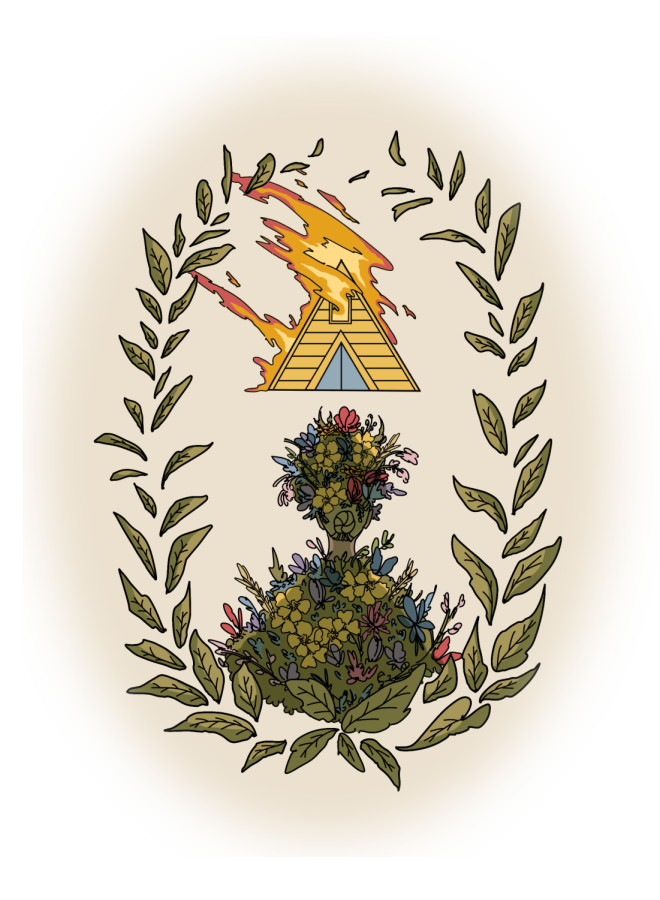Horror Rewind: Two years later, ‘Midsommar’ still preys on empathy
The most captivating thing about “Midsommar” — the thing that has kept audiences watching it again and again — is that viewers are faced with cult indoctrination alongside Dani.
October 26, 2021
Two long years have passed since the iconic release of A24’s “Midsommar” in 2019, but the film still remains equally as unsettling and chilling as ever. Ari Aster, the film’s director, managed to create a haunting depiction of cult indoctrination, grief and the cycle of life all entirely in broad daylight.
“Midsommar” does not hide itself in darkness and cheap jumpscares that can be accomplished under the cover of night; it shows every gruesome detail under the bright, almost 24-hour sun of rural Hälsingland, a small Swedish town.
The film follows Dani (Florence Pugh), a graduate student who has recently suffered an unimaginable tragedy. Devastated, she leans on her uninterested boyfriend Christian, who is embarking on a trip to a Swedish commune, the Hårga, with his friends from grad school. Much to the reluctance of the group, Dani is invited on the trip under the assumption that she won’t accept the invitation, but surprisingly, she does.
The group arrives at the commune during its nine-day mid-summer festival and quickly realizes that beneath the frivolity, flowers and traditional costumes, there is a much darker purpose to the rituals that ensue, leading to death, torture and the failure of Dani’s relationship.
Through symbolism and foreshadowing of events to come, “Midsommar” is not a film you can watch once and be done with. Every viewing uncovers something new that the audience may have missed, which is one of the reasons why it is still so prevalent in horror circles.
“Midsommar” is not only rich with intense, careful storytelling; it is also aesthetically jarring. The film’s editing and camera work make you feel more connected to the storyline in every scene. It’s like a car crash — you want to look away, but you can’t take your eyes off it. It forces you to look at the blood and gore while juxtaposing it with beautiful scenery and blindingly white costumes.
During all of the drug trips that the characters partake in, the screen before you adapts to show the way the characters perceive their surroundings as they begin to feel the effects of the psychedelics.
When Dani participates in a psychedelic trip for the first time, we see grass growing out of her body as characters converse about their feelings of connectivity to the earth. The trees move and breathe with her, and things are calm at first. But as her trip worsens, the soundtrack distorts, the people she interacts with are laughing at her, and as she looks in a mirror, her face morphs, and we can see an image flash of her dead sister behind her.
By far the most captivating thing about “Midsommar” — the thing that has kept audiences watching it again and again — is that viewers are faced with cult indoctrination alongside Dani. Pugh’s acting skills as Dani are phenomenal, and this element would not have been possible without her. Her sobbing and screams, as she suffers through coming to terms with her trauma and witnessing the horrors of the Hårga, are often more devastating and unsettling to watch than the actual gore in the film.
As viewers, all we want is for Dani’s suffering to end. She has been painted as a character deserving of so much empathy, and we feel for her. As she is slowly adopted into the cult, many people on their first watch will be happy for her. Members of the Hårga welcome her into the family, and as she screams in emotional pain, so do they. She finds a purpose, a home, a new life.
But as you think about it more deeply, you remember that this is a pagan cult — a cult that killed Dani’s friends, a cult with strong underlying hints at white supremacy. And you think about the fact that you, too, were tricked for a moment into believing that this was the right thing for Dani. “Midsommar” proves how easy it is to fall into cult-like thinking: preying on your empathy for a suffering woman whose pain the Hårga exploit.
That’s the scariest thing about it — under the bright sun of Hälsingland, the film itself is working to indoctrinate you, too.







